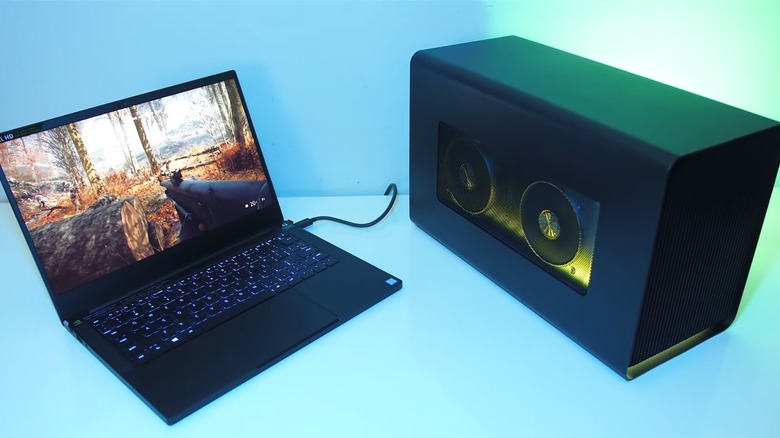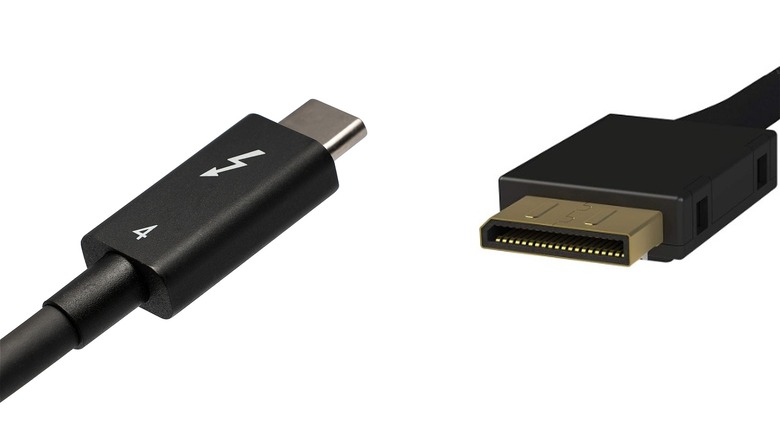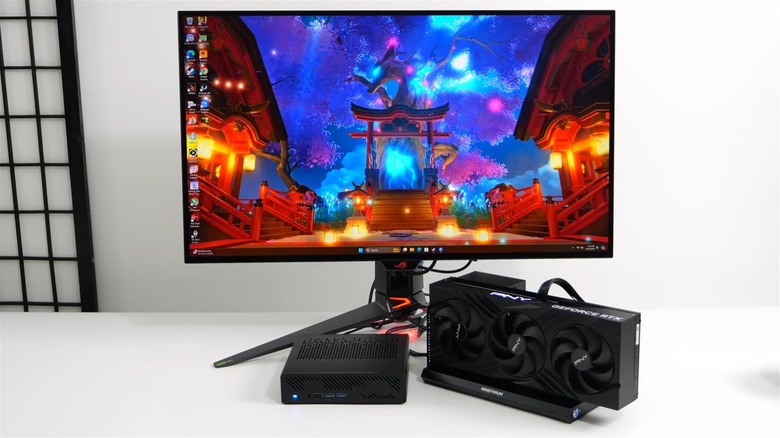What Is An eGPU And Does Your Computer Need One?
We may receive a commission on purchases made from links.
Laptops can be incredibly convenient due to their thin and lightweight form factors, making them extra portable. For those into gaming, however, laptops with an integrated GPU or a budget-friendly mobile graphics card can provide less-than-ideal performance. Desktop GPUs have a distinct advantage in that they aren't held back like laptop GPUs in terms of memory bandwidth, power draw, size, and thermal restrictions.
So, is the only solution for a serious gamer to go with a desktop rig or sink some serious cash into a top-of-the-line gaming laptop? Not so fast! There is another intriguing pathway towards more frames per second and superior graphical fidelity: an eGPU. An eGPU, or external graphics processing unit, allows you to connect and utilize a desktop graphics card, boosting performance. Options like the Alienware Graphics Amplifier have been around for a decade now, but newer options like the yet-to-be-released Alienware Polaris EGPU concept are improving on the idea. The GPD G1 Docking Station, for example, features an RX 7600 XT, with options for both OCuLink and Thunderbolt connections.
Unfortunately, there are some issues with an eGPU, primarily latency, which limits the potential of potent GPUs. However, if your aging laptop is working sluggishly during games or other demanding applications and can accommodate either OCuLink or Thunderbolt 3 or 4, an eGPU utilizing a mid-range desktop card could be a decent option. Similar to Windows users, for those in the Apple ecosystem, macOS external GPU support comes with good and bad news.
Latency and connection options
One of the most significant drawbacks of an eGPU is that it's hindered just by the fact that it's externally connected to your PC. There are back-and-forth pathways transferring data from every component of the system through the peripheral component interconnect express (PCIe). The information is measured in Gigabytes per second (GB/s), and currently, an eGPU can only connect in a way that uses around a quarter of the pathways available to a GPU installed in a desktop unit.
The impact of many fewer data pathways can be felt during gaming as a delay in the player's inputs and micro-stuttering, which is a jarring disruption in the delivery of smooth, rendered frames. The most common methods to connect an eGPU to your laptop include Thunderbolt and OCuLink. Thunderbolt and USB-C look almost identical, but there is an obvious difference. Intel also recently launched the latest iteration of their connection technology, Thunderbolt 5. Although many devices may not yet support it, meaning you'll have to use Thunderbolt 3 or 4, which aren't the fastest options in terms of transferring data.
OCuLink (Optical-Copper Link) can offer real-world bandwidth figures around 8GB/s, whereas Thunderbolt 4 tops out at just 5GB/s. The problem with OCuLink is that it hasn't been as widely adopted as Thunderbolt but is on the rise.
Diminishing returns and cost
You'd think that the prospect of boosting your laptop's graphical prowess with an eGPU would be more popular. So why are eGPU products in such a seemingly small niche instead of mainstream? Two major disadvantages have kept eGPUs from becoming hugely successful, which has diminished returns and prices. First off, you might wonder what would happen if you just added an RTX 4090 to your laptop. Well, as it turns out, this would be a colossal waste of money, as benchmarks have discovered the more powerful a card, the more it's throttled by the transfer rate bottleneck. In fact, the difference between NVIDIA's most powerful card in an appropriately equipped desktop versus an eGPU connected by Thunderbolt 3 can be nearly 100 frames per second. Fortunately, much less powerful mid-range cards don't experience such a discrepancy in performance figures, making them a far better option.
The other problem has to do with the cost of an eGPU. Some of them come with a GPU and power adapter, but others require you to purchase not only the dock but also a card and power supply. An all-encompassing eGPU with everything included can run you around $700. An eGPU dock can retail for around $130, plus the cost of a card and PSU (power supply unit), meaning you're likely looking at spending several hundred dollars, depending on prices. While it may not be the right setup for everyone, picking the right eGPU for your laptop or gaming PC can still make it a worthwhile investment.


